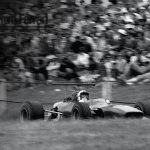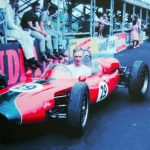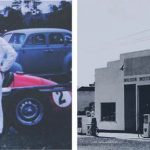
Won for the road Aston DB3S vs Jaguar D-Type. Mick Walsh gets an exclusive road run in a pair of endurance racing legends. Jaguar D-type and Aston DB3S: hitting the highway in two of the greatest sports-racers ever built. Words Mick Walsh. Photography James Mann/Motorsport Images.
JAGUAR D-TYPE VS ASTON DB3S
Two of the greatest endurance racers go head to head…on the public road!
“The DB3S never had the power of the D-type,” said Roy Salvadori. “You could drive the Jaguar as a gentleman, but you had to be a hooligan in the Aston”
The mid-’50s yielded some of the most beautiful sportsracers ever built, super-fast toolroom marvels in an era when teams and privateers still drove out to famous races. A few entrants in historic events continue that tradition, relishing the run down to Goodwood or over the Alps to the Mille Miglia as much as the competitive thrill. The late Norman Dewis regularly drove D-types back across France from Le Mans and loved slowing down through towns to hear the cheers and shouts of, “Vive les Jag-wahs!”
“The D-type handled virtually like a touring car,” said racing journalist Paul Frère. “It was so easy to drive and so flexible”
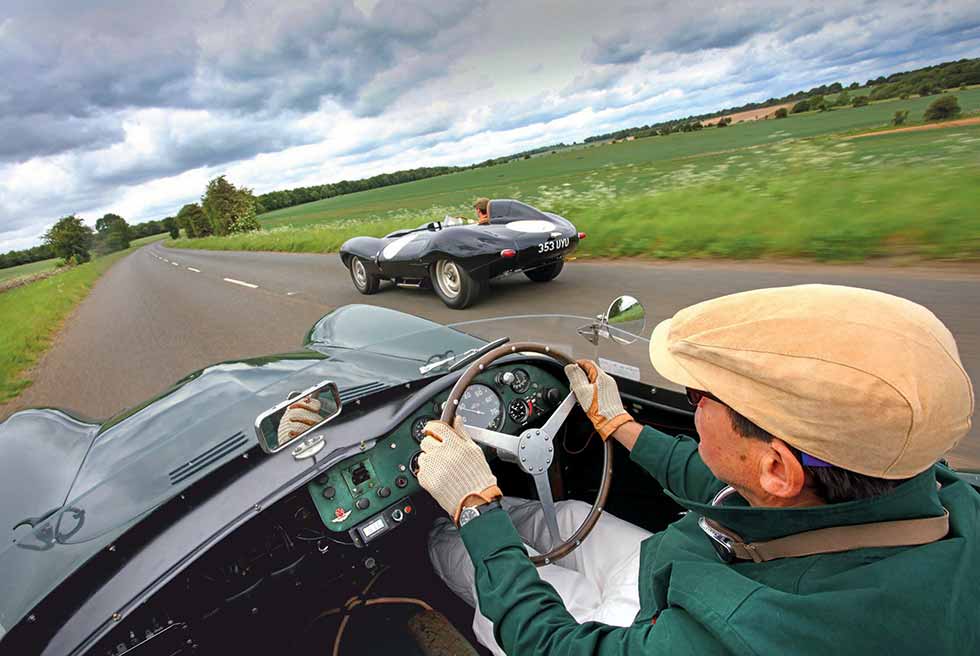

When Belgian Paul Frère won at Spa in 1955 for Aston Martin, the works DB3S/8 was driven out from Feltham by a solo mechanic with no support vehicle. After a dominant win from pole, beating two Equipe Nationale Belge Ferrari Monzas, the car was driven from the track to the palace of keen Aston owner King Baudouin for a test drive. “We went out on the Brussels- Antwerp road,” recalled Frère. “The DB3S had no protection for the passenger. On seeing my king’s cheeks distended by the wind at 90mph, I asked if he was all right. He nodded and made a sign to go faster.” The royal later got his revenge when he drove Frère back to the palace.
To celebrate that much-missed duality of these glorious front-engined sports-racers, we have united two fabulous English rivals to discover which is the supreme all-rounder. Both had twin-cam straight-six engines evolved from road-car units and cost a whopping £3600-plus when new, but they couldn’t be more different in design approach. In an attempt to sell more cars, both were available as road versions, the Aston as a coupé and the Jaguar as the awesome XKSS, the fastest British road car offered for many years. But as original racers on the open road, can the aviation-inspired, highly specialised D-type match the old-school DB3S, which aces such as Jaguar legend Mike Hawthorn rated the best-handling sports car ever built?
‘In works green with distinctive yellow nose and front wing flares, the DB3S has the aura of a WW2 fighter plane – it’s a Hurricane to the D-type’s Spitfire’
In its works green colour embellished with a distinctive yellow nose and front wing flares, the DB3S has the aura of a WW2 fighter plane. Stylist Frank Feeley transformed Aston Martin’s racing look from sturdy, slab-sided machines into a lithe, athletic profile. With its wide-intake mouth and muscular wing line, it balances function with aesthetic flair.
For me, the charismatic DB3S is the Hawker Hurricane to the D-type’s smoother, more advanced Supermarine Spitfire. Distinctively evolved features such as the offset Borrani wheel rims, full-width windscreen and exhaust sprouting from the inner wing all add to its character, but contrast with the resolved, cleaner form of the Jaguar. The juxtaposition of the two fuel fillers perfectly encapsulates the outlook of the two designs – the Aston’s huge exposed cap centred on its beautiful tail, the D-type’s flushfitting solution hidden in the headrest.
The old fighter-plane aura continues in the busy cockpit. The exposed doorhandle would have worried Jaguar designer Malcolm Sayer – the D-type has a simple pull-cord on the inside – and that functional, workmanlike character dominates the layout. The cluster of black, white-numbered dials, random off-the-shelf switches, exposed cloth-covered loom, upright rear-view mirror and check-upholstered bucket seats give the look of a ’50s special, but it did the job. Accessibility rather than aesthetics was the priority, as the crossed cables over the gearbox cover underline. The Astons were often underpowered compared to rivals, so boss John Wyer and his team knew they could save time in the pits with quick access for repairs. Alongside the restored D-type’s interior, the Aston’s chipped paint and scuffed leather vividly evoke this car’s past and you immediately feel privileged to sit where Aston Martin greats did their heroic best. Just holding the wooden rim of that broad, three-spoke steering wheel, stained with years of sweat and oil, is richly evocative.
The feeling of sitting on the chassis with a view over the ’screen seems vintage compared to the snug, deep cockpit of the D-type. No key is needed to start it. Switch the fuel pump on, flick down the ignition tog, thumb the prominent button in the centre of the dash and the 3-litre ‘six’ erupts with a thunderous bark.
The sensitive throttle is crisp and sharp, with little flywheel effect, and with the exhaust exiting under the driver’s-side sill the sound has a deafening growl within the confines of a garage.
Fitting earplugs would be sensible, but I’ve always listened to my favourite music too loud. The Aston’s hopeless lack of lock and heavy steering make manoeuvring a busy challenge. The stiff action of the gearbox and hefty clutch don’t help, while over secondary-road bumps the limited suspension rattles and bangs. But the jittery ride and steering kickback are soon forgotten once on to smoother surfaces, when the DB3S really comes to life. The agricultural action of the gearchange gets cleaner as the revs rise, while the sharp worm-and-roller steering inspires precise cornering attacks. With no servo the brakes initially feel dead and take a hefty heave into tight turns, but they always pull up straight and strong, with no hint of locking. The engine accelerates cleanly from low down but feels strongest between 3000 and 4000rpm, when the exhaust’s resonance is spine-tingling.
As you thunder past hedgerows, nothing scares crows like the Aston’s belligerent roar.
Through the turns, the chassis feels balanced and perfectly matched to the power. The fluid, nimble character underlines the car’s viceless reputation, and on a clear track it would no doubt be beautifully controllable. Little wonder
drivers enjoyed the DB3S in wet conditions. Driving on country roads in this valuable machine only scratches the surface of the Aston’s performance potential, but the historic car’s inspiring controls and balanced chassis reinforce its revered reputation. As you blast along to that hammering exhaust note, the interior’s wellworn charm only makes the experience more special and you can really feel its rich history.
In contrast, the restored D-type looks factory fresh, just as it rolled out of the Coventry works for shipping to Australia. Sayer’s streamlined masterpiece looks lower and more taut than the rival Aston. The clean-sheet approach led to a race-bred purity that blends organic curves and lean athleticism, with every detail considered for smoother airflow. Where the Aston’s wheelarches are cut high, the D-type’s overhang the distinctive aluminium Dunlop wheels, the body looking almost too big for the track.
Stretching inside to release the flimsy little door, the more modern, ordered approach to the cockpit design and layout is a far cry from the Aston’s busy, cluttered affair. Stepping over the broad sill and slipping your left leg under the wheel can’t be rushed, as Tony Rolt discovered after putting his foot between the spokes. After the archaic Aston, the pilot’s seat of the spartan Jaguar, set low inside the monocoque, seems to have moved into the jet age. Neat, ordered and clean, it has an uncompromising purity with its crackle-black dash finish, comfortable seat cushion and press-studded trim. Unlike the DB3S, the D-type’s white-on-black dials include a speedometer marked to 180mph. Wyer no doubt felt that his drivers could feel how fast they were travelling and vigilance of engine revs was more important, while Jaguar’s William Lyons appreciated the promotional prestige of his car’s staggering top speed.
With the key turned, the fuel pumps start to tick and, after priming the triple Webers, a big plastic button lights up the potent, long-serving straight-six. The exhaust exit on the passenger side explodes with that unmistakable roar. Matched to the voluptuous bonnet curves viewed over the wraparound Perspex ’screen while the engine warms, the D-type’s cabin is a soul-stirring place that immediately conjures images of Jaguar legend Mike Hawthorn.
The stubby gearlever is cranked so far forward that your knuckles almost touch the transmission tunnel when changing up from second to third. From the off, the sharp shift has ArmaLite precision and you never tire of changing down for an excuse to blip the throttle.
The engine has masses of torque, pulling strongly from 1500rpm, while the smooth flow of power delivers spectacular acceleration. Accompanied by that deep-chested exhaust blare, on the straights the D-type feels massively fast. Lift off at higher speeds and with fractional retardation you can almost sense the iconic shape spearing cleanly through the air.
Designed to win on the fast, smooth surfaces of Le Mans, the D-type’s live rear axle struggles on bumpy country roads, but the superb rack-and- pinion steering makes it easy to correct any breakaway on a sudden loose patch. Unlike the Aston, its suspension doesn’t bang and rattle over pockmarked roads. Only the brakes fail to inspire, the erratic Plessey pump assistance resulting in poor feel, but this may be down to the racing pads fitted to ‘our’ car.
Contemporary pilots confirmed the contrasting character of these magnificent sports-racers. “The Aston never had the power or the torque of the D-type,” said Roy Salvadori. “If you were racing against the Jaguar you had to do some tricky stuff to get by; it was all done on the braking and cornering. But then the D-type would always sail past on the straight. You could drive the Jaguar as a gentleman but you had to be a hooligan in the Aston. You really had to bully it.”
Stirling Moss drove both cars, but only three times in a D-type. “The DB3S was a really good road-race car,” recalled Moss. “They handled nicely, and felt small and easy to drive, but their engines were very pernickety about the rev limit. The rev band always seemed very restricted. You could run it up to the redline in an intermediate gear, change up, and the power would just seem to have faded. But the handling always made up for the lack of power. It was always a forgiving car that you could throw around – rather like my favourite Maserati 300S, but with less power. The Aston was prone to lifting its inside rear wheel under hard cornering, which would cause it to spin. Sometimes one had to ease off to prevent this happening in corners in which other cars might sustain full throttle all the way.”
On a winding road circuit, Moss maintained that the DB3S would out handle a D-type every time: “Coming to the Aston direct from the Mercedes-Benz 300SLR, I found the DB3S so much smaller, lighter and easier to drive. For a circuit such as the Nürburgring I would have loved to combine the nimbleness of the DB3S with the sheer speed and reliability of the SLR. That would have been the perfect car.”
Moss’ view of the D-type is possibly coloured by frustrating unreliability, because his only finish in one came after pushing the Jaguar across the line at the ’54 Dundrod Tourist Trophy to salvage 18th with failed oil pressure. “It was a beautiful Jaguar,” said Moss, “perhaps the most charismatic of them all. But it was very much a precision instrument tailor-made for Le Mans, and not at all a rough-road or aerodrome racer. Compared to the C-type, the D-type was certainly stiffer, quicker and more precise. It was ideal on the smooth and very fast expanses of Le Mans and Reims, but on an undulating road circuit such as Dundrod it wasn’t as responsive or as manoeuvrable as a DB3S.”
Racing journalist Frère was another who drove both – including 62 EMU with Peter Collins to second at Le Mans in 1955. “It rained for more than half the race,” said Frère. “Peter and I were quite good in the rain; it also suited the Aston because it was rather underpowered. I really enjoyed the DB3S, which was a very fine car, much more of a racing car than the D-type. The D-type handled virtually like a touring car, it was so easy to drive and so flexible. The Aston in comparison was harsher, with a noisier, less flexible engine and a more difficult gearchange.
The D-type had extremely light brakes, nearly as light as the accelerator, whereas the Aston’s brakes needed quite a hard push.”
Aston works legend Tony Brooks confirmed the appeal of the DB3S: “We had some pretty hot drivers in those days and it was just as well. Although the DB3S handled and braked beautifully, we were struggling for power against the Jaguars and Ferraris. Wherever there was any kind of straight we were at a disadvantage, but this was good training because you really had to drive those Astons to be competitive.” Brooks always rose to the challenge, and on his first visit to the Nordschleife in 1956 he was 16 secs faster than teammate Collins and finished fifth: “I liked the ’Ring, and because the DB3S handled so well it was easier to be competitive.”
The DB3S and D-type are high on my all time list and their divergent characters make it a tough choice. Both are rewarding on the road, the Aston’s more balanced handling matched by the Jaguar’s shattering pace. In the race for the keys the D-type’s mould-breaking and seductive design is alluring, but the history and precious patina of 62 EMU are equally tempting. To own the very car my hero Collins raced has special appeal, and if forced to choose I’d take the Aston – mostly because it’s a proper two-seater and there’s nothing like sharing the experience. Riding shotgun in a D-type with the exhaust cooking the floor soon loses its appeal.
Thanks to Martin Chisholm at The Classic Motor Hub. For details of its popular Coffee & Classics gatherings, see classicmotorhub.com
Reworked cylinder head and triple Webers turn the already mighty Jaguar XK twin-cam straight-six into a fire-breathing race winner, with 270bhp. Clockwise from main: D-type cockpit is focused and logical, with sharply cranked gearlever; fin was removed during rebuild; signature Dunlop alloys. D-type’s curvaceous body envelops its wheels in the search for wind-cheating performance, while the pretty Aston Martin looks upright in comparison. The Stirling Moss/Peter Collins DB3S holds off the Jaguar D-type of eventual winners Ninian Sanderson/ Ron Flockhart during the 1956 Le Mans 24 Hours. Clockwise from main: the workmanlike cockpit of a racer; playing Le Mans on Cotswolds roads; offset Borrani wires with three-eared spinners. Magnificent twin-plug, twin-cam straight-six has its origins in the road-car engine designed by WO Bentley, but lags around 45bhp behind the Jaguar.
ASTON MARTIN DB3S
Sold/no built 1953-’1956/31 (including 20 customer cars) Construction steel tubular frame with aluminium body
Engine iron-block, alloy-head, dohc, twin-plug 2992cc straight-six, triple Weber 45DCOE carburettors
Max power 225bhp @ 6000rpm
Max torque n/a
Transmission David Brown four-speed manual, RWD via ZF limited-slip differential
Suspension: front independent, by semitrailing arms rear de Dion axle with central slide, trailing links; torsion bars, telescopic dampers f/r Steering worm and roller
Brakes discs (occasionally drums)
Weight 1962lb (890kg)
0-60mph 6.6 secs
Top speed 140mph
Price new £3684 (inc Purchase Tax)
DB3S/6 IN DETAIL
Few Aston Martin registrations are as famous as 62 EMU, which through its factory team years led a dramatic life with impressive results, accidents and various rebuilds. DB3S/6 disappointed on its 1954 debut as a coupé at Silverstone, where Roy Salvadori was unhappy with the handling at speed.
Four weeks later at Le Mans Prince Bira crashed it heavily on the approach to Maison Blanche, in the same spot where another DB3S coupé had rolled. Both accidents happened at night in the wet at high speed, when suspect aerodynamics may have caused the front end to go light.
Both coupés were reborn as open single-cockpit cars, but with the old chassis numbers and their spec improved with twin-plug heads, Girling discs and ZF diffs. The new DB3S/6 won first time out at Silverstone in May with Reg Parnell, followed by second at the tragic 1955 Le Mans with Peter Collins and Paul Frère. Collins continued to race DB3S/6, including second at Aintree and third with Tony Brooks in Goodwood’s Nine Hours. At Dundrod his performance was sensational but brief: last away after starting problems, Collins stormed back to fourth before the engine blew.
The car was rebuilt again in 1956 after Collins was involved in a four-car pile-up at Silverstone’s Club Corner. Fitted with drum brakes at Collins’ request, it made its return at Rouen but teammate Stirling Moss proved quicker in practice and took it over to score an impressive second after chasing winner Eugenio Castelotti’s Ferrari 860 Monza.
Salvadori gave the car its final works outing with fourth in Oulton Park’s Daily Herald Trophy (above). At the end of 1956 Aston booked Silverstone to test prospective drivers. Tragically, Mark Lund lost control of DB3S/6, the subsequent roll proving fatal. The car was badly damaged but again rebuilt, possibly with a new frame. The famous chassis and registration continued in a new car for privateer Graham Whitehead – a dodge to avoid Purchase Tax, which was more than 40% of the basic price.
The great car survives as delivered to Appendix C spec for the start of the 1957 season, with two doors, full-width ’screen and faired-in lights but no headrest. Whitehead raced to the end of 1958, teaming with half-brother Peter to take a superb second at Le Mans in 1957, which saved Aston’s reputation when all the new DBR1s failed.
In 1959 next owner Mike Bond took 62 EMU to Africa, but once home it continued to win events with the AMOC. Since the ’60s this famous DB3S has been prized by respected collectors, with the latest owner returning 62 EMU to Goodwood for this year’s Members’ Meeting. This is undoubtedly one of the all-time great Aston Martins.
JAGUAR D-TYPE
Sold/no built 1954-’1958/67 (including 16 XKSS road cars)
Construction magnesium semi-monocoque with steel multi-tubular front subframe
Engine iron-block, alloy-head, dry-sump, dohc 3442cc straight-six, triple Weber 45DCOE carburettors
Max power 270bhp @ 5750rpm
Max torque 256lb ft @ 4500rpm
Transmission all-synchromesh four-speed manual, RWD
Suspension: front independent, by double wishbones, longitudinal torsion bars rear live axle, torsion bars, radius arms, A-bracket; telescopic dampers f/r
Steering rack and pinion
Brakes discs, with gearbox-driven servo
Weight 2187lb (992kg)
0-60mph 4.7 secs
Top speed 170mph (Le Mans ratio)
Price new £3633
XKD526 IN DETAIL
D-types were sold all over the world, including two to Australia. The first to arrive was XKD526 in the joint ownership of Jaguar agent Cyril Anderson, racer Bill Pitt and Charles Swinburn, who later sold his share. Anderson’s wife Doris, better known as ‘Geordie’, immediately entered XKD526 in sprint events and became the only woman to compete in a new D-type, setting a Queensland state speed record of 135.2mph at the Leyburn sprints.
Pitt was XKD526’s regular pilot on circuits, with impressive results including a second at Bathurst behind Stan Jones (father of Alan) in a Maserati 250F. Pitt’s first season ended in drama at Albert Park, where he lined up with Europe’s best including Stirling Moss, Ken Wharton and Jean Behra. Bob Stillwell’s D-type jumped the start and a frustrated Pitt ran too deep into the first turn. After touching the kerb, XKD526 rolled. Marshals put out the fire and got the car back onto its wheels, but were shocked to find no driver. Pitt had been thrown out and, worried about being hit by Jack Brabham’s Cooper, jumped a 6ft wall of hay bales to safety.
The D-type returned to Brisbane for repair and emerged in bronze paint with a modified nose and a 3.8-litre upgrade that ensured it remained highly competitive Down Under. Later, XKD526 became the only D-type to be fitted with a hardtop when Formule Libre was replaced for 1961 by a new GT championship. The six-year-old Jaguar, wearing a striking Mako Shark livery inspired by the Corvette concept car, won several times before next owner Barry Topen crashed at Sandown Park. Amazingly, the aluminium fastback body survives.
From 1966 the Jaguar was owned by Keith Berryman, who restored it to original specification and treasured the great car for half a century. He also raced it occasionally until a full rebuild by Ian Cummins at Classic Autocraft began in 1976. The monocoque was reskinned and a new front frame was made before the car was finished in ’82. The pristine D-type was a star at prestige Australian events including the 1985 Bathhurst 1000 when paraded by Tom Walkinshaw and Win Percy. For the new Jaguar F1 team’s debut at the Australian GP in 2000, XKD526 was enlisted for promotional work with both Eddie Irvine and Johnny Herbert enjoying drives around Calder Park (above).
In 2015 the car returned to England when acquired by Lord Bamford, who enlisted Chris Keith-Lucas’ team at CKL Developments to refit the original front frame and prepare XKD526 for a competition return at the Goodwood Revival. Now racing in new hands, the Jaguar looks even more authentic with the recent removal of its fin, and is regarded as one of the finest short-nose D-types.
THE GREATEST SPORTS-RACERS
The ’50s was a golden era for sports cars; this group vied with the Aston and Jaguar for top honours. Words Mick Walsh. Photography Motorsport Images.
AHEAD OF THE PACK Our pick of the best ’50s sports-racers
The ultimate sports-racer of the mid-’50s was undoubtedly the Mercedes-Benz 300SLR. In contrast to its rivals, the Benz was entered exclusively by the factory, with none of the nine built sold to privateers. Of six events contested in 1955, the 340bhp masterpiece won five and withdrew from the lead at Le Mans after Pierre Levegh’s horrific accident. Although it was designated the 300SLR for marketing reasons, the prototype was known at the works as the W196S, hinting at its development from the GP single-seater.
Advanced features included a spaceframe chassis, desmodromic straight-eight with Bosch injection, five-speed transaxle and inboard drum brakes. The SLR famously won on its Mille Miglia debut, where Stirling Moss and co-driver Denis Jenkinson averaged 97.95mph across 992 miles. During the 1955 Le Mans the Jaguar D-type was timed at 185mph on the Mulsanne while the Mercedes peaked at 179mph, but the Coupé version posted 180mph when driven by designer Rudolf Uhlenhaut on a closed autobahn. Although Mercedes was dominant, the SLR wasn’t as much fun to drive as the beautifully balanced Maserati 300S, which Moss rated as his favourite from this era. Its 3-litre straight-six was developed from the 250F and, with a five-speed ’box mounted in-unit with the final drive, the multi-tubular chassis was a joy to control. Results didn’t reflect the 260bhp car’s potential, and in 1955 it failed to win a championship race. Moss began 1956 with victory in Buenos Aires, but Maserati couldn’t prevent Ferrari taking the title. “In its general feel and responsiveness, the 300S was like the DB3S but even better balanced,” said Moss. “It was infinitely superior to any front-engined sports Ferrari.”
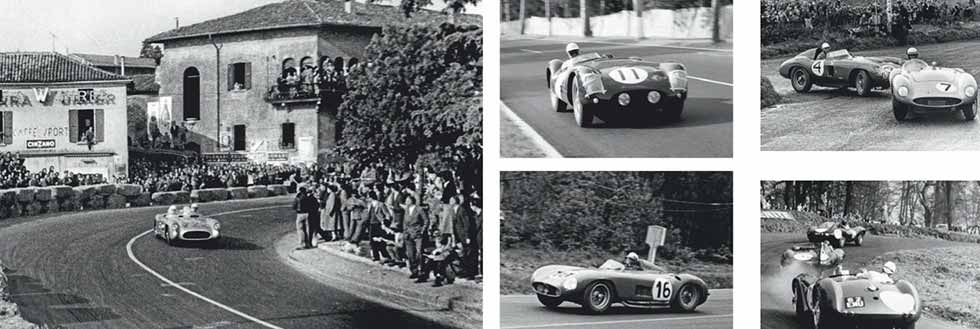
Aurelio Lampredi’s dominant four-cylinder Ferrari F2 engine proved ideal for a line of sports cars, first the 2-litre Mondial, then the Scaglietti- bodied 3-litre Monza. Ultimate power was limited and the handling tricky, particularly with the earlier transverse-leaf front suspension, but its meaty torque helped Mike Hawthorn to win the TT around the Dundrod road circuit, and the Supercortemaggiore GP at Monza before the Scuderia switched back to V12s in 1956. British independents fought hard against the works teams, and in the Jaguar XK engine they found the power they needed. Cooper was the first to try to better the factory C-type with a run of toolroom sports-racers starting with the unconventional T33 for wealthy amateur Peter Whitehead. The prettier T38 failed at Le Mans and on the Mille Miglia in period, but is now a regular winner in historics. HWM was another team to move successfully from single-seaters to sports cars. It built just two Jaguar-powered Series II chassis, but the team might have gone on to greater achievements had founder John Heath not died on the 1956 Mille Miglia.
Today the values of these glorious machines mean few are raced, but thankfully they are still tempted out for the Goodwood Revival. With the exception of the priceless Mercedes, lucky owners can still drive them on the open road, too – a key part of their lasting appeal.

